Content
Radish is classified as an early vegetable, depending on the variety, it can ripen for several weeks from the moment of germination. But the picture from the package does not always correspond to the grown vegetable, so that such a situation does not overtake you and it is most reliable for you to grow seeds at home on your own. There is nothing difficult in this, the main thing is to observe some nuances.
Breeding features
You need to start with the fact that the radish is an annual cruciferous plant. In the first year, you can collect seeds from it for future sowing, but only after they were personally convinced of the full compliance of the grown vegetable.
A feature of reproduction is two ways of growing a mother plant, this is what the stem is called, from which the testes are later collected.
It is advisable to sow radishes early, preferably under a film, since the testes take a long time to ripen.
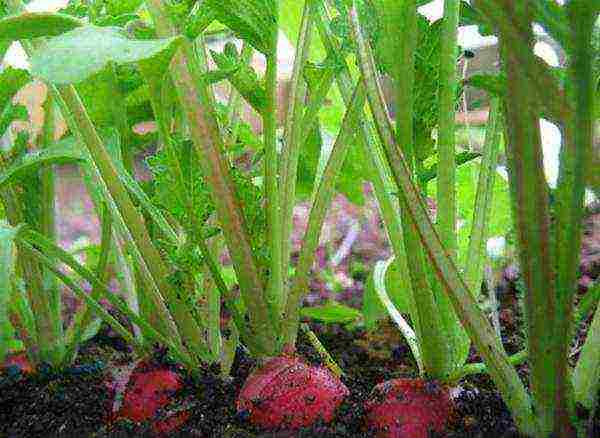 Growing radish
Growing radish
Choosing a variety
Generally speaking, any vegetable you like will do the trick for harvesting radish seeds. Even one stem left will give a sufficient amount. You need to choose a mother plant like this:
- First of all, the vegetable is inspected, it should be flawless, smooth and elastic.
- The radish fruit must fully correspond to the declared variety, have all the peculiarities of color and taste.
- The tops of the selected stem are green, dense, without pests and diseases.
It is such a stem that will give the seeds of the best quality, if you follow certain rules for planting and growing a mother plant. According to gardeners, one mother plant can produce about 20 g of seeds, while a thousand seeds weigh 7-10 g.
Before choosing a variety, make sure it is not hybrid. Pure-sorts or plants of the first reproduction will be ideal, they will retain all the properties of the selected variety.
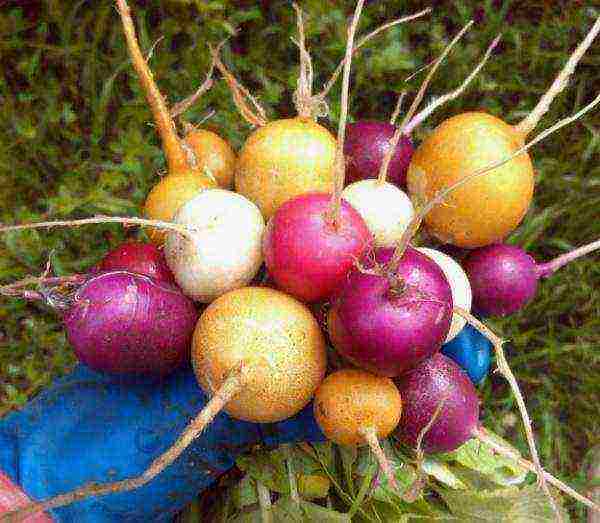 Radish varieties
Radish varieties
How to properly grow radishes at home
After we have decided on the variety and selected a suitable stem, it is necessary to find out by what method we will grow radishes to obtain seeds.
Experienced gardeners distinguish between two methods for growing radishes for seeds:
- Non-transplanting is rarely used, this is due to the fact that this method gives less seeds, their ripening is delayed for 160 days. At the same time, there is a threat of dusting when radish and other, less liked varieties of radish can "join" your stem. With the direct method, the plant is not dug up or transplanted, it continues to grow in the place where the seeds were sown.
- The second, more common is the transplant method of growing radishes for seeds. It allows you to select outwardly more beautiful root crops that will exactly match the picture on the package. Testes will ripen with this method early, after just 120 days.
In order to grow radishes for seeds in this way, I completely dig out root crops at the stage of full maturity, select only varieties that are ideally suited to the description. After that, the tops of the boles are cut off, the cuttings are left about 3 cm. The horse system is also shortened, no more than 4 cm is left, the dive will help the plant to quickly drive out the peduncle, on which the radish seed pods are subsequently formed.
 Radish seed pods
Radish seed pods
After such procedures, it is worth choosing a place for planting the uterine stem, here special attention should be paid to neighboring plants, among them there should not be other varieties of radishes, radishes or other crucifers.It is best to plant root vegetables away from the main beds, in a quiet place protected from the wind.
There should be enough sun for the trunk, as well as moisture. The distance between the plants should be at least 40 cm; during planting, you must strictly monitor that the rosette of the petioles is not sprinkled with soil. It is important to prune and replant on the same day to avoid drying out the root crop.
With proper care, after 2-3 weeks, the stem will drive out the arrow, on which soon the buds will appear immediately, and then the flowers themselves. In radishes, they are not very beautiful, usually yellow or white, collected in a spikelet, but with a strong odor. After the plant has faded, pods are formed on the arrow, in which the seeds will be until fully ripe.
When the peduncle reaches 60-70 cm, it is advisable to tie it to a peg so that the testes do not fall to the ground.
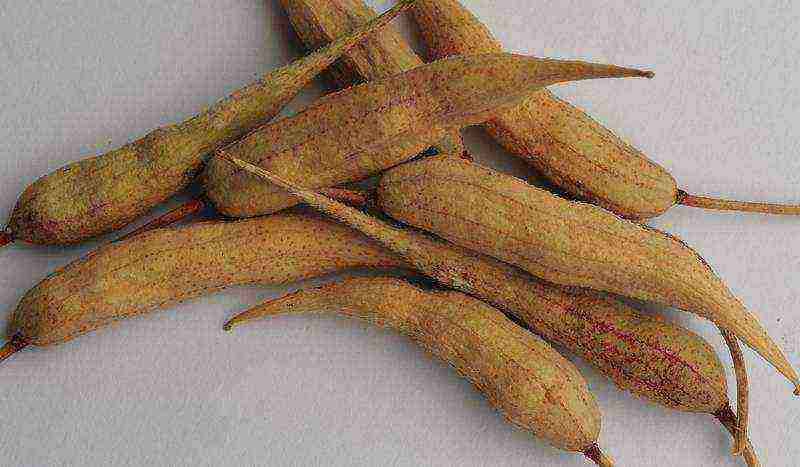 Dried radish seed pods
Dried radish seed pods
How to assemble
You can harvest radish seeds after they ripen in the seed pod. The main sign of maturity is a change in the color of the pods, from green they turn into pale yellow or beige. Usually this period begins in the middle of autumn, at this time it is worth cutting off the peduncles with testes and drying them in the attic or shed. There must be good ventilation in the room, otherwise the pods will simply rot. You can also dry it in the kitchen or on the balcony of a city apartment.
After the cut arrows dry well, you need to get the seeds themselves. But not always with a simple splitting of the pods, only seeds pour out from there, often with them husks and other unnecessary impurities fall into the collection container. Everyone wants to have clean seeds, how can this be done? There is one simple and proven way.
After about three weeks of drying, the pods will completely dry out, and the seeds in them will ripen, check this by simple crushing. If the integumentary skin crumbles in your hands, then it's time to remove the grains.... After that, the pods, along with the seed pods, are accurately pounded, as a result, a homogeneous mass with small particles from different parts of the testis should be obtained.
Grind not very finely, just enough so that the pods open and the grains spill out of them.
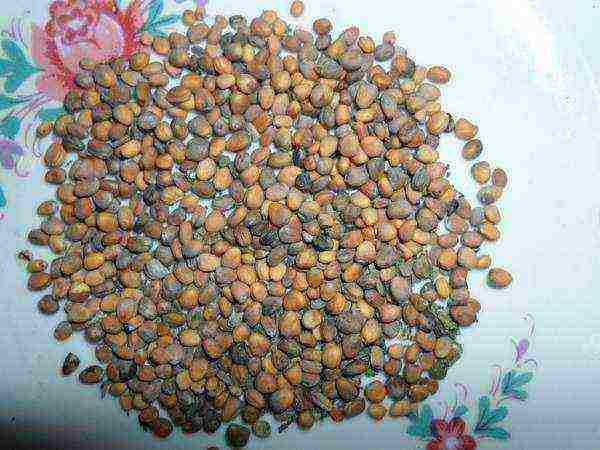 Radish seeds
Radish seeds
After that, the resulting mass is poured into a container, poured with water and left for 5-10 minutes. During this time, all unnecessary cake will rise to the surface, and the radish seeds will settle to the bottom. Debris is carefully caught from the container and the water is drained. The seeds themselves are dried and laid out in prepared paper bags or in fabric bags.
Be sure to sign the harvested crop and remember that the seeds retain a good percentage of germination for 4-5 years.
So we collected the seeds from the radish, the process is not complicated and laborious. But you will definitely get the desired root crop variety and can save your budget at least a little.

Radish is one of the most delicious and healthy plants that you can grow on your site. To grow radishes, you need to know some of the features of this crop, in particular, to study the agricultural technology of growing radishes. Only with the right approach can you get a good harvest.
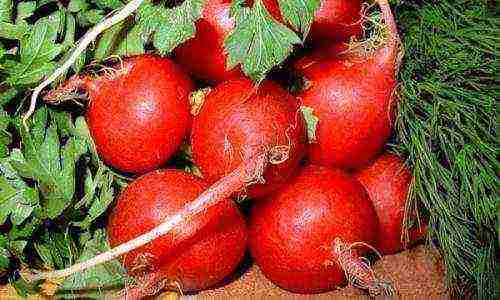
Radish is an annual plant. It can be characterized as an early ripening, moisture- and light-loving plant, resistant to cold weather.
As a rule, radishes belonging to the European group are grown in our latitudes. This variety has a one-year development cycle, that is, the maturation of roots and seeds occurs within one season. There are also biennial radishes. In this variety, root crops ripen in the first year, and seeds in the second.
The use of radish in food helps to eliminate vitamin deficiency. This is especially true in early spring. This effect is provided due to the high content of B vitamins, vitamin C and other useful substances in the radish.
Required conditions for sowing
To obtain a rich harvest, it is necessary to provide certain conditions for the radish.
Scheme of the neighborhood of vegetables by type of fertilizer.
Radish takes root well only if it is planted in loose and light soil. This garden crop does not tolerate drought, so the soil must be well moistened. The soil environment should be neutral or slightly alkaline. The area where radish is planned to be planted in spring is recommended to be plowed in autumn and applied to the soil with mineral fertilizers.
Before planting radishes, it is advisable to fertilize the soil with rotted compost and wood ash. For 1 sq. m. use half a bucket and 200 g of fertilizer, respectively. If you plan to sow early, then it is recommended to make the garden beds high enough (15-18 cm). The beds must be loosened before sowing. Landing should be done in an area that is well warmed up by the sun.
Radishes love sunlight, so they need to provide bright lighting. If the daylight hours lasts more than 13 hours, then it is advisable to darken the radish. Otherwise, the sprouts will bloom. The optimum temperature for radish is in the range from 16 to 18 degrees. The plant does not tolerate temperatures over 20 degrees. Radishes can sprout at +3 degrees, and already sprouted sprouts can withstand light frosts (up to -3 degrees).
By growing radishes in a greenhouse, you can harvest every 2-3 weeks. You can start growing radishes in the greenhouse immediately after the topsoil thaws (up to 10 cm).
Radish seeds need to be planted in grooves that need to be moistened. Seeds can be soaked before sowing, or they can be planted dry. They should be placed at a depth of about 2 cm. The distance between them in the bed should be about 5 cm, and the distance between the rows should be 10 cm. Until the first shoots appear, it is recommended to cover the beds with a film. This will help to retain heat and moisture in the soil. The seeds should germinate in about a week. If necessary, seedlings can be thinned out.
Radish needs regular, moderate watering. If the plant does not have enough moisture, then the roots will grow tough and bitter. Over-watering the radishes can cause the roots to crack. You can feed the plant with mineral fertilizers, it is advisable to use readily soluble forms.
Back to the table of contents
Pest and disease control
Vegetable cultivation compatibility chart.
The main threats to radishes are cabbage flies and cruciferous fleas. Protection from these pests will be provided by spraying with an infusion based on wood ash and tobacco dust, the components must be sieved beforehand. It is strictly forbidden to use chemicals to destroy pests.
If the cultivation of radishes is carried out on soil that has an acidic environment, then root crops can be affected by a viral disease - keel. If this happens, then growths will form on the root crops. the affected plants must be destroyed, and to prevent the spread of the disease, the soil must be treated with special disinfectants.
Back to the table of contents
The subtleties of growing
Sometimes the radish behaves unusually, in such cases it is necessary to perform additional actions on the plant. For example, if the sprouts are too stretched, then the beds need to be hilled. If yellowness forms on the tops, then you need to feed them with fertilizer containing nitrogen. The soil must contain a sufficient amount of potassium, otherwise the root crop will not form. It is best to grow radishes in the place where potatoes, legumes, cucumbers or tomatoes grew before. But radish cannot be planted in the soil into which manure was recently introduced. In addition, cruciferous roots and cabbage are not the best predecessors for this plant.
If you want to get radish seeds for further sowing, then you need to plant radishes under a film and at an early date.Hybrid varieties are not suitable for obtaining seeds, since they do not transmit all their qualities to the offspring. To obtain seeds, you need to choose the largest plants, cut the tops on them so that cuttings about 3-5 cm long remain.About three weeks a powerful stem will appear, which can reach 80 cm.When the pods containing the seeds open on the seed stem , it can be cut off.
In order to extend the shelf life up to 3-5 days after harvesting, it is necessary to water the radish in the evening the day before, and in the morning to harvest and clear the roots of the soil. The tops must be trimmed, but not completely; about 2-3 cm must be left. The roots must not be shortened. After that, the radish is placed in a plastic bag, it must be stored in the refrigerator. If you have harvested a radish of autumn planting, then you can store it at temperatures from 0 to +10 degrees in the cellar. In such conditions, the radishes of autumn planting will remain until the end of winter.
By following these tips, you can get a great harvest of radishes that you can use to vary your diet or sell.

Foreword
Buying new radish seeds, the gardener often runs the risk of being left without a crop, because currently there is practically no regulation of this market. Manufacturers, wanting to make high profits, fill colorful bags with low-quality seed. How to get your own high-quality seeds while maintaining varietal characteristics?
Breeding features
Growing radishes in the garden, you can see that the roots of the radish after a while begin to grow stiff and shoot. This is the initial stage of the appearance of the peduncle, on which the seeds will then form.
Let's take a look at the main characteristics of this crop as a seed plant.
Radish belongs to the Cabbage family (formerly called Cruciferous due to its cross-shaped flower with petals). Cabbage, radish, rapeseed and mustard as well as rape weed are close relatives. Radish is a cross-pollinated plant, but self-pollination is also possible. Pollen is mainly carried by insects, but wind pollination is also acceptable. All varieties of radish are easily pollinated with each other, as well as with cultivated and wild radishes. With other species of the Cabbage family, it is usually not cross-pollinated in nature.
The flower has four yellow petals. The fruit is called a pod, in which 4-8 seeds are formed. The size of radish seeds is small, the weight of 1000 pieces is only 8-12 grams, i.e. in 1 gram from 80 to 130 seeds.
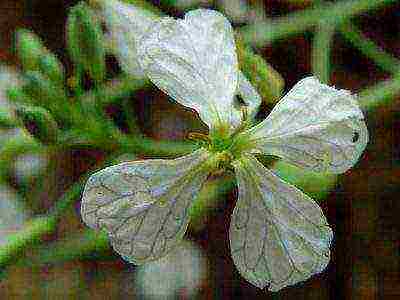
Radish blooms only on a long day for more than 13 hours, usually starting in June.
The plant that produces the seeds is called the testis.
How to choose a breeding variety?
Try sowing multiple varieties. First, seed radishes are grown in the same way as commercial ones, then the best one is chosen from these crops. Whichever we like, we will multiply. You can even choose several, but for this you must comply with some conditions, the description of which will be below.
F1 hybrids cannot be used for reproduction. When receiving seeds, they do not retain varietal characteristics, and a re-grading is obtained or, perhaps, none at all.
Breeders use different protection methods when creating them in order to preserve authorship. But let's not be discouraged, because there are many wonderful varieties that are no worse than hybrids.

Each sown variety is designated with a label, and its characteristics are recorded in a notebook: ripening period, color and size of the root crop. This will be necessary for further selection of the best root crops that match the description.
Features of growing seeds
We will use the transplant method to obtain radish seeds, as it allows us to better select the necessary plants, as well as to preserve the variety and its characteristics. The non-stop method is usually used on industrial plantations.
One seed plant usually produces 15-20 g of seeds.To provide a small area with seed, about 10 seed plants are enough.
The sampling of planting material is started during mass ripening of root crops, then varietal differences and resistance to flowering are clearly visible.
To obtain a high-quality seed plant, it is necessary to select the best plants according to the following characteristics, corresponding to this variety:
- even shape and color;
- large size;
- no cracking of root crops;
- a small amount of true leaves 5-6 in the outlet;
- lack of shooters, the root crop does not stiffen for a long time and does not form a peduncle.

On the selected plants, pinch the root, leaving 3 cm and remove almost all the outer leaves, leaving 3-4 in the very middle of the rosette. This stimulates the root crop to form a peduncle and new roots.
Before planting, the testes are dipped in a mash, which is made from cow dung, clay in a 1: 1 ratio, adding water to a creamy state. This will keep the plants pulled out of the soil from drying out and will promote the rapid formation of new roots. The distance between the planted plants should be about 50 cm. The planting depth is such that the root crop sinks 2-3 cm into the soil. The planted testes are watered and covered from the sun with non-woven material, such as Lutrasil or Spunbond.
The selected radish is planted together so that so that it can be isolated. Isolation is needed to prevent unwanted pollination with neighboring plants, which may be even at a distance of 500 m. If pollinated with another variety or wild radish, the varietal qualities of the seeds are lost, and they may not even set a root crop. A non-woven material is used for insulation. As soon as the testes drive out the arrow and at least one flower begins to bloom, the entire plot is covered with insulating material, and the flowers that have opened before covering are removed. If we get radish seeds of different varieties, then each plot is isolated separately and preferably, so that it is on the site at the greatest distance.
2 weeks after the end of flowering, the insulating material can be removed, and the arrows with green pods must be tied to a support to avoid damage by the wind. Testes must be treated against damage from pests and diseases. To do this, use a mixture of preparations Fufanon 10 ml and Skor 1 ml per 10 liters of water.
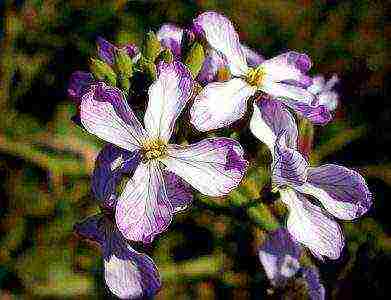
After a month, the seeds begin to ripen and they are again covered with non-woven material to protect them from being eaten by birds.
In mid-August and early September, the testes are removed from the site, tied together of the same variety and dried in the shade, for example, in the attic, until all parts are completely dry, they should become from light yellow to beige.
Then they begin to thresh the pods. To do this, they are separated from the plant, and gently rubbed in their hands. Yellow-brown seeds fall out of them.
Usually a mixture is obtained with garbage, pod remnants. To clean it, you need to sort the seeds with a fan. To do this, spread the fabric and sprinkle the mixture through the moving air. Dry residues and underdeveloped seeds are light, therefore, pouring the mixture in a fast air stream, heavy seeds fall, and debris flies away. The operation can be carried out several times, while the heaviest seeds remain, then, moving away, then, bringing the trickle closer to the fan. After that, you can carry out manual sorting and select the largest seeds that will have a germination rate close to 100%.
The finished seeds are placed in a paper bag, the name of the variety and the year of cultivation are signed.
Radish seeds remain viable for up to 7 years, but the germination energy is lost, i.e. seedlings are uncooperative. Therefore, it is recommended to get your seeds every year.
Which radish seeds are best?
There is a wide variety of varieties on the market.Among them there are both old, well-proven for a long time and possessing the properties of yielding even under unfavorable conditions, and new ones, which give an increased yield under optimal conditions. We offer a choice of some of the best varieties of radish.
Zarya... An early ripe old variety, yields a harvest on days 20-26. Ties roots well both in the greenhouse and in the open field. Having sown this variety, you can always count on a guaranteed yield of small root crops weighing 15-20 g with a bright red color. The rosette of leaves is small, medium pubescent, which protects the leaf from pests. Round radish with a diameter of 4-5 cm. Contains a lot of ascorbic acid, which is useful for maintaining human immunity.
Sora. The record variety for resistance to flowering, it does not bloom even when grown in summer. The rosette has so few leaves that it is sometimes difficult to pull it out of the soil. Root crops are rounded red with tender juicy pulp. It differs in that it forms a fairly aligned product. Ripens by 19-21 days from sowing.
Coral... Possibly the only cultivar that yields well in low light in winter and tolerates cold temperatures. It can be used for cultivation in glass greenhouses in winter, but in early spring it develops rather quickly. Ready to harvest 22-27 days after sowing.
18 days... One of the earliest modern varieties that allows you to get the first harvest already on 17-19 days under a film greenhouse, and in the open field - on 20-21 days. Elongated original red roots with a white tip will delight any gardener. Radish has a tender, without bitterness, pulp, it is very juicy and dense. It gives the harvest amicably and does not shoot for a long time.
Premier... An amazing variety that combines early maturity and productivity. Rounded red roots with a white tip reach an incredible size - up to 30 g or more, which is commensurate with the size of a ping-pong ball. The white, juicy pulp has an original mildly pungent taste. Ripe radish is resistant to the formation of voids and does not expel the arrow for a long time.
Malaga. Lilac-raspberry roots, unusual for radish, can be obtained by growing this variety. They are smooth, beautiful, with juicy tasty pulp, they do not stiffen for a long time. The variety is resistant to unfavorable growing conditions.
Zlata. A stunning early ripening variety with yellow roots. The crop can be harvested as early as 22-25 days. Rounded radish has a white juicy flesh. The variety is resistant to flowering. Root crops do not become woody even with low soil moisture, which is a great advantage over other varieties.
From the varieties listed above, you can choose the best radish seeds and propagate them on your site.
Rate the article:
(0 votes, average: 0 out of 5)


